

Click on the images to ENLARGE.
The majority of Australian spiders are new to science. Most southern hemisphere spiders are unknown!
Australia leads the world in the number of venomous spiders as well as the toxicity. However, of almost 10 000 species of spiders in 70 families throughout the country, most are harmless to humans and interesting to study.
 Latrodectus hasseltii
Latrodectus hasseltii
Most spiders in Australia are venomous but only two have caused deaths, the Funnel Web and Redback.
The Redback is the most well known Australian spider and found in all areas except the highest mountains and deep in the ocean.
She can store sperm up to two years then lay 10 egg sacs, each containing about 250 eggs, and can repeat this a week later.
Closely related to the Black Widow and identical except for the red dorsal stripe.
The Redback "venom is highly neurotoxic, which is to say that it attacks the central nervous system causing intense pain, profuse sweating, difficulty in breathing, loss of consciousness, violent convulsions and, finally...Death."
Prior to the introduction of specific antivenom in 1956, Redbacks had been responsible for thirteen deaths in Australia. None since!
Most spiders are predators with eight legs, eight eyes, fangs and venom but the the most prominent feature is the ability to produce silk.
Silk is used as a safety-line, to catch prey, wrap up prey and to make egg sacs.
It is also used for transport, shelter and courtship.
 Nephila edulis
Nephila edulis
The Golden Orb spider gets her name from the beautiful golden, orb-shaped web that she makes. This web is the largest and strongest in the world.
The tiny males live on the edge of her web feeding on small insects. They are so small that
they can sneak in for a quickie without the female noticing. But if they are caught they may get eaten.
![]()
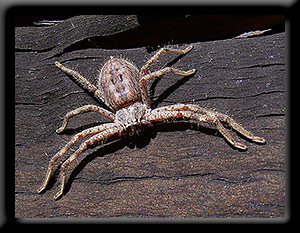 Isopedella flavida
Isopedella flavida
Huntsman spiders are those big, hairy, scary, long-legged spiders we often find behind curtains, in the shower cubicle and under the car's sun visor.
These timid creatures are harmless and will run from humans at lightning fast speeds.
The design of the legs allows the Huntsman to run sideways as well as forward.
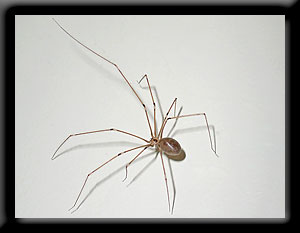 Pholcus phalangioides
Pholcus phalangioides
Daddy Long-legs hunt, kill and eat Redback Spiders, House Spiders, Wolf Spiders and more. An ideal pet to keep in the house.
When hunting other spiders it will tap the victims web to attract it, quickly envelope it with silk and then inflict the fatal bite.
When threatened by a touch to the web the Daddy Long-legs become invisible by vibrating rapidly and becoming blurred. Their main predator is the vacuum cleaner.
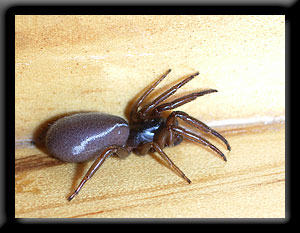 Badumna insignis
Badumna insignis
Segestriidae - Tube-dwelling spiders have only six eyes.
They build a tubular web with radiating silk triplines for detecting prey. (Monitored by the six forward legs.)
 Thomisus spectabilis
Thomisus spectabilis
Flower Spiders (or Crab Spiders) are colourful and camouflage well in flower petals. This serves a dual purpose of hiding from potential predators and concealing from possible prey.
They feed on nectar feeding insects including bees.
This spider has been immobilized by the sting of a wasp and will become living food for the larvae.
Garden orb weaving spiders are common in yards during summer. They build their webs in the evening and before daylight will usually eat the web, then hide all day.
They are non-aggressive and low risk to humans but walking into a web at night can cause panic, especially if the spider is on your face.
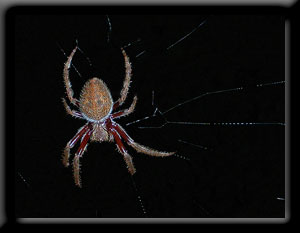 Eriophora biapicata
Eriophora biapicata
This Garden spider ejected about 10 super-fine silken threads, over a metre long and joined at the end. This blanket of silk floated to a nearby plant and attached to a leaf.
The spider then pulled in all the slack silk lines until it formed one strong anchor thread for the foundation of the web. The spider didn't move!
All the indoor pics were taken inside my house. I removed the Redback,
the Daddy Long Leg ate the Black House spider and Harry the Huntsman is still here.
![]()
 Austracantha minax
Austracantha minax
Jewel Spiders (Christmas or Spiny spider) are orb weavers.
These tiny spiders are usually found on a web strung between two bushes.
They look like a creature you don't wanna touch.
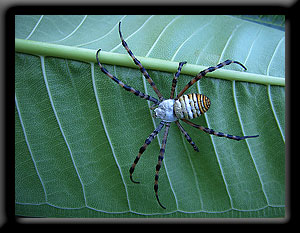 Argiope trifasciata
Argiope trifasciata
Banded Garden Spider or Banded Argiope
Generally seen arse-up in the centre of an orb web, with legs together in pairs. Trifasciatas are found throughout Australia around autumn. Often mistaken for the St Andrews Cross spider which is only found in the east.
These awesome creatures are totally harmless.
Tiny immature wolf spiders hiding in the dunes at Cape Range NP, Exmouth.
Wait until dark, grab a torch, enter the sand dunes and hold the torch about eye-level. The bright pinpricks of light in the sand are reflections from the spiders eyes. I saw up to 10 from one location.
When alarmed the spider will quickly disappear into the sand.
 Lampona cylindrata
Lampona cylindrata
Here is a Flickr group on Australian spiders with a search function. You can post spider pictures and get feedback from others.
Check out Jean's collection of spiders from W.A.
Most Popular Comment
Cherry - Huntsman Spiders are my favourite. I used to be terrified of spiders as a kid, but then my dad found a young one and said it looked hungry, so I caught it in my brother's bug catcher and gave it a few flies. It tried to gobble up three flies all at once, and after that I was no longer afraid of spiders. I decided to keep "Inci" as a pet, and after a few months of feeding him daily, he shed his skin. It was an awesome sight watching it happen. Anyway, he moulted every few months, and grew to as big as my dad's hand. Inci grew so tame that he would know when I was picking his cage up to feed him, (he'd get all excited), or when I was just picking it up to handle him. I let him run up and down my arm under my jumper sleeve and out at my neck like a pet mouse would. To make a long story short, I found so many interesting things about huntsman spiders (I decided to breed them and have studied them for about 7 years). Their venom is pink; the males are hairier and have more red-fuzz around their fangs than females; if they lose legs, they grow back at the next moult; and their blood is a clear turquoise colour. The females lay an egg-sack that's about the size of a ten cent piece, and have about 100+ spiderlings in each one. When the babies hatch in the egg-sack, the mother will chew a hole in it to let them out, and she counts them as they come out by having a foot over the hole. I've heard a lot of people think that they can jump, but they don't. If they're afraid they'll run, then suddenly drop off the wall they're on. Generally if you don't bother them, they won't bother you. ;-)